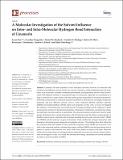| dc.description.abstract | Linamarin has been reported to have anticancer activities; however, its extraction and
isolation using different solvents yield a low amount. Therefore, understanding the physical prop‐
erties, such as solvents’ solubility, membrane permeability and lipophilicity and how they are asso‐
ciated with different solvents, is a paramount topic for discussion, especially for its potential as a
drug. Linamarin has a sugar moiety with many polar groups responsible for its physical properties.
Following current trends, a molecular dynamics simulation is performed to investigate its physical
properties and how different solvents, such as water, methanol (MeOH), dimethyl sulfoxide
(DMSO) and dichloromethane (DCM), affect such properties. In this work, we have investigated
the influence of intermolecular and intramolecular hydrogen bonding and the influence of polar
and non‐polar solvents on the physical properties of linamarin. Furthermore, solvation free‐energy
and electronic structure analysis are performed. The structural analysis results show that the polar
groups of linamarin have strong interactions with all solvents except the etheric oxygen groups. A
detailed analysis shows intermolecular hydrogen bonding between polar solvents (water, MeOH
and DMSO) and the hydroxyl oxygens of linamarin. Water exhibits the strongest interaction with
linamarin’s functional groups among the investigated solvents. The findings show that within the
first solvation shell, the number of water molecules is greatest, while MeOH has the fewest. Cen‐
trally to the structural analysis, solvation free energy confirms DMSO to be the best solvent since it
prefers to interact with linamarin over itself, while water prefers to interact with itself. While the
solute–solvent interactions are strongest between linamarin and water, the solvent–solvent interac‐
tions are strongest in water. As a result, the solvation free‐energy calculations reveal that linamarin
solvation is most favourable in DMSO. | en_US |

